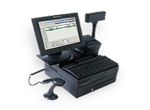
Restaurant point of sales (POS) systems help streamline cash management operations while increasing return on investment (ROI) in the process. The POS system lowers costs, increases efficiency and improves customer service. The system also creates an improved working environment for your employees.
The number of restaurants that use POS systems is increasing rapidly and those businesses that still use traditional cash management systems are in danger of falling behind the competition.
POS system costs can vary considerably. First, you have to consider that the capabilities of each solution can vary widely. Basic systems can handle ordinary customer transactions, but most POS solutions will have added features that can include:
- Credit card processing
- Inventory tracking and management
- Purchase order management
- Personnel record keeping
Generally, the cost of a restaurant POS system will depend on the features provided with the more advanced systems costing more. However, this may not always be the case, so it is a good idea to shop around and compare different solutions. You can even find some free POS software systems, but generally these do not include customer support and they can be very limited in what they offer.
A full restaurant POS system will include not only the software package but also the other equipment used for point of sales operations including the computer, monitor, keyboard, cash drawer, scanning equipment, printer and customer display screen.
POS system costs
If you are only looking for POS software, you can find very cheap solutions ranging from only $100 or even less to about $1000. A more complete POS system including hardware can cost up to $20,000 or more.
An average complete POS system installed with custom features will probably cost between $1000 and $7000 in most cases. If you need more than one terminal, expect to pay about $1000 to $4000 per terminal on average.
Often you can save by purchasing refurbished POS systems that can cost around $500 to $1500. If you already have hardware, then you can look for lower cost software or even try out free POS software solutions.
A Halo restaurant POS system with four terminals, four remote printers, four cash drawers and integrated payment capability will cost you $12,466 upfront:
- Terminal equipment: $10,468
- Activation and training: $1,499
- PCI compliant payment processing: $499
The Halo system also requires a $396 monthly subscription cost so the total startup cost for the first month is $12,862 after which you pay the monthly subscription.
A SoftTouch POS system including software and hardware costs about $12,000 and includes:
- Four POS software licenses
- Four LCD display touch screens with card readers
- Dining room and bar features
- Take-out and delivery features
- Cash drawer
- Four receipt printers
- Wireless router
- Customer support and training
The POSqx system is a good alternative for those who need scalable services. The POSqx system requires no upfront software purchases. Everything is included in a monthly fee including support and maintenance. Pricing is based on the number of terminals needed:
- 1 terminal -- $99 per month
- 2-5 terminals -- $89 per month per terminal
- 6-10 terminals -- $69 per month per terminal
- 11 or more terminals – Call company for quote
How do POS systems help?
A POS solution provides advantages to restaurants in terms of cutting down on wasted time and resources.
- Improved business performance – POS systems help integrate your overall business operation more effectively and efficiently. Everyone in the establishment can easily know in real time what is going on in every sector of the restaurant. For example, the cook is instantly aware when a new order enters the system. In this way, you save time and energy, and avoid miscommunication.
- Real time tracking capability – A POS system records everything that is going on in the restaurant in real time. Every order and sale is available for easy scanning right as it happens.
- Data recording capability – POS systems can record everything that happens every business night and you can store this data for later retrieval. By studying records of past performance, you can identify areas in your operation that need improvement.
